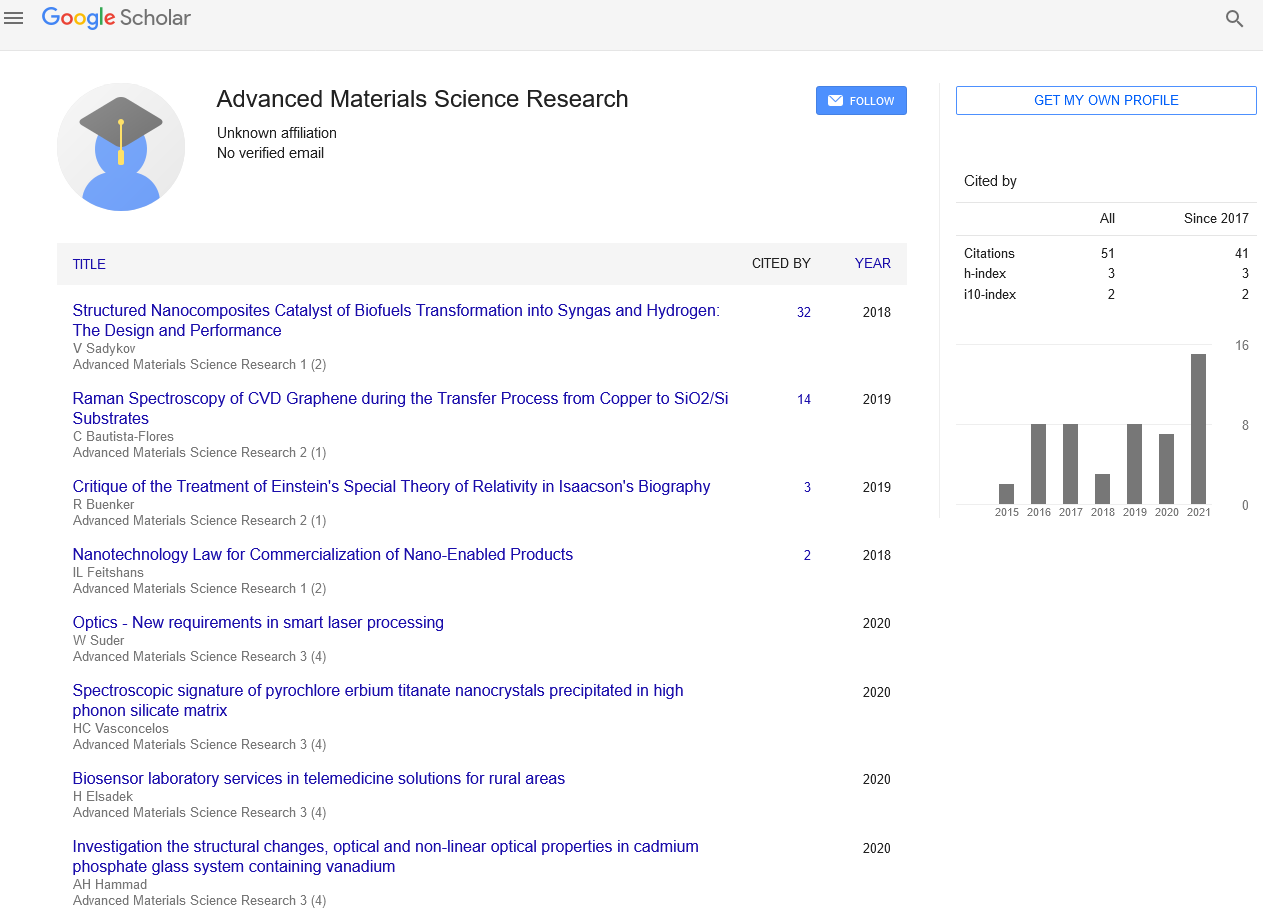Perspective - Advanced Materials Science Research (2023) Volume 6, Issue 5
Calcium Copper Titanate: A Comprehensive Overview
- Corresponding Author:
- Xu J
Department of Chemistry,
Shanghai Jiao Tong University,
Shanghai,
China
E-mail: uujkl@ding.com
Received: 04-Sep-2023, Manuscript No. aaamsr-23-118960; Editor assigned: 07-Sep-2023, PreQC No. aaamsr-23-118960 (PQ); Reviewed: 21-Sep-2023, QC No. aaamsr-23-118960; Revised: 03-Oct-2023, Manuscript No. aaamsr-23-118960 (R); Published: 19-Oct-2023, DOI: 10.37532/ aaasmr.2023.6(5).88-89
Introduction
Calcium copper titanate, also known as CCTO, is a remarkable material that has garnered significant attention in the field of advanced ceramics and electronic materials due to its unique electrical and dielectric properties. This compound, with the chemical formula CaCu3Ti4O12, exhibits a perovskite structure and has been studied extensively for its high dielectric constant, colossal permittivity, and potential applications in various electronic devices. In this article, we will explore the properties, synthesis methods, applications, and recent advancements related to calcium copper titanate.
Discussion
Physical properties
One of the most striking properties of calcium copper titanate is its colossal permittivity, which is several orders of magnitude higher than that of conventional dielectric materials. This property makes CCTO an ideal candidate for high-k dielectric applications. The high dielectric constant, which can exceed 10,000, allows for miniaturization and increased capacitance in electronic components, making it valuable for the development of capacitors, resonators, and other passive components.
Additionally, calcium copper titanate exhibits a nonlinear dielectric response, which means that its dielectric constant is strongly dependent on the applied electric field. This characteristic makes it suitable for use in devices such as varistors, which protect electronic circuits from overvoltage conditions by rapidly changing their resistance with increasing voltage.
CCTO is also a semiconductor with a wide bandgap, typically in the range of 3.5 eV to 3.9 eV. This property makes it interesting for potential applications in optoelectronic devices, such as light-emitting diodes and photodetectors. Furthermore, calcium copper titanate is a magnetoelectric material, meaning it can exhibit magnetoelectric coupling effects under an external magnetic field. This property opens up possibilities for the development of multifunctional devices that can be controlled by both electric and magnetic fields.
Synthesis methods
There are several methods for synthesizing calcium copper titanate, each with its own advantages and disadvantages. Some of the commonly employed techniques include:
Solid-state reaction: This method involves mixing calcium oxide, copper oxide, and titanium dioxide in the desired stoichiometric ratio and heating the mixture at high temperatures (usually above 1000°C) to form CCTO. The solid-state reaction method is simple and cost-effective but requires high-temperature processing.
Sol-gel process: In this approach, a precursor solution is prepared by dissolving calcium, copper, and titanium salts in a solvent. This solution is then subjected to gelation, followed by a heat treatment to form CCTO. The sol-gel process allows for better control of the composition and microstructure but is more complex and time-consuming.
Hydrothermal synthesis: Hydrothermal methods involve the reaction of precursor solutions under high-pressure and elevated temperatures in a sealed vessel. This method can yield high-purity CCTO nanoparticles and is particularly suitable for applications in nanotechnology.
Mechanical activation: Mechanical activation techniques, such as ball milling, are used to reduce the particle size of the precursors and enhance their reactivity. This method can lead to the formation of CCTO at lower temperatures, reducing energy consumption. Template-Assisted Synthesis: Templates, such as carbon nanotubes or polymers, can be used to control the structure and morphology of CCTO during synthesis, allowing for the creation of tailored nanostructures. The choice of synthesis method depends on the specific application and desired properties of the calcium copper titanate material.
Applications of calcium copper titanate
CCTO’s unique electrical and dielectric properties make it a promising candidate for various applications, including:
High-K dielectric materials: Due to its colossal permittivity, CCTO is used in highcapacitance components like multilayer ceramic capacitors and tunable microwave devices. Its high dielectric constant allows for the storage of more charge in a smaller volume, which is essential in miniaturized electronics.
Varistors: Calcium copper titanate’s nonlinear dielectric response makes it suitable for use in varistors, which are essential components in surge protection devices, safeguarding sensitive electronic equipment from voltage spikes.
Optoelectronic devices: CCTO’s wide bandgap makes it suitable for use in optoelectronic devices, such as Light-Emitting Diodes (LEDs) and photodetectors. It can help improve the efficiency and performance of these devices.
Multifunctional devices: The magnetoelectric properties of CCTO open up possibilities for creating multifunctional devices that respond to both electric and magnetic fields. These devices have potential applications in sensors, data storage, and energy harvesting.
Nanotechnology: CCTO nanoparticles synthesized through hydrothermal or templateassisted methods have applications in nanotechnology, including catalysts and nanocomposites.
Research and development: CCTO is also of great interest in scientific research due to its unique properties. It serves as a model system for studying colossal permittivity and other complex phenomena in condensed matter physics.
Recent advancements in CCTO research
Ongoing research in the field of calcium copper titanate continues to uncover new properties and potential applications. Some recent advancements include:
Tunable microwave devices: Researchers have been working on utilizing CCTO in tunable microwave devices, which can dynamically adjust their electromagnetic properties. This is crucial in modern wireless communication systems and radar technology.
CCTO Nanocomposites: Incorporating CCTO nanoparticles into polymers or other matrices has shown promise in developing novel materials with enhanced electrical and dielectric properties for various applications.
Synthesis of nanowires and nanotubes: Innovative techniques have been developed to synthesize CCTO nanowires and nanotubes, which can be employed in nanoelectronics and nano-optoelectronic devices.
Energy harvesting: CCTO’s multifunctional properties make it a candidate for energy harvesting applications, where it can convert both electrical and magnetic energy into usable power.
Improved scalability: Efforts have been made to scale up the synthesis of CCTO to meet the demands of the electronics industry and make its incorporation into commercial devices more feasible.
Conclusion
In Conclusion, Calcium Copper Titanate (CCTO) is a fascinating material with exceptional electrical and dielectric properties, making it a subject of extensive research and a potential game-changer in various technological domains. Its colossal permittivity, nonlinear dielectric response, and magnetoelectric properties offer numerous possibilities for advanced electronic and optoelectronic devices. Ongoing research and innovations continue to expand the applications of CCTO, and it is poised to play a significant role in the future of electronics and materials science.

